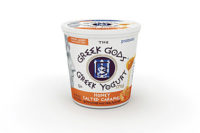This year, Velvet Ice Cream, a family-owned processor in Utica, Ohio, brought out a new design for its 56-ounce ice cream containers.
“The new packaging was designed to appeal to the younger fans that grew up on Velvet, yet remain loyal to the brand and are now introducing their own families to Velvet Ice Cream,” said President Luconda Dager.
She told Dairy Foodsthat it was important that the new packaging remain true to the Velvet brand so that consumers would know that the recipe had not changed. Only the packaging is different.
“We’re coming up on our 100th anniversary in 2014. Trends, like gluten-free products, are always changing and we thought this was the perfect time to redesign,” Dager said. “Now more than ever our customers are looking for a gluten-free product. We wanted to draw attention to the fact that most of our ice creams are gluten-free.”
Besides redesigning package graphics, dairy processors are also looking for new containers. Tetra Pak and Ecologic were two suppliers that introduced new packages at the Private Label Manufacturers Association show in November 2012 in Rosemont, Ill.
Tetra Pak presented the Tetra Evero Aseptic package, a 1-liter bottle specifically for aseptically processed white milk. The company said the benefits of the carton include easy handling and pouring by consumers. For manufacturers and retailers, the visual appeal of the package “provides maximum branding impact with printing possible across the whole surface of the package.”
“Food and beverage manufacturers are continuously challenged to create more user-friendly products that offer grab-and-go portability and innovative design,” said Suley Muratoglu in a statement. He is the vice president of marketing and product development. “We’ve developed packaging solutions for shelf-stable and refrigerated food products that fulfill consumer needs while enabling product differentiation for private label owners,” he said.
Other products exhibited by Tetra Pak addressed environmental concerns. Muratoglu told Dairy Foodsthat consumers age 18 to 35 (known as “millennials”) “hate waste.” Tetra Pak’s Green PE bottle caps are made of high-density polyethylene derived entirely from sugar cane, a renewable feedstock. The production process for the caps will result in a reduction of greenhouse gas emissions compared to traditional manufacturing methods for polyethylene, the company said.
Tetra Pak’s Recart is a retortable carton package marketed as an alternative to cans, glass jars and pouches. Because the packages are shipped flat, one standard truck loaded with empty Recart packages holds the equivalent of nine trucks with empty cans, the company said.
Containers from recyclable materials
Ecologic Brands of Oakland, Calif., introduced a new molded paper canister for dry products. One of the first users of the container is The Winning Combination Inc. The company uses the eco.canister for its BodyLogix protein powder.
Ecologic is the supplier of the eco.bottle line of containers made of recycled cardboard and newspapers. The shell is 70% cardboard and 30% newspapers. These are integrated with an inner pouch made from #4 low-density polyethylene. The company says this represents a 60% plastic reduction, compared to traditional canisters of the same size.
This canister measures approximately 6.3 inches in diameter and 9.75 inches tall. It can hold 100-ounces (3 liters) of product, weighing up to about 2 pounds. The top load is 70 pounds.
Ecologic said the containers are suitable for brands in the health and wellness category, and for powder blends, tablets, capsules and liquids.
Another recyclable material is glass. That has found favor with Traders Point Creamery, Zionsville, Ind., a processor of organic dairy products. Healthy living and recyclable packaging are important marketing messages for the company. The processor packages drinkable yogurt in single-serve 5-ounce glass bottles. The organic yogurt, made with milk from 100% grass-fed cows, is available in four flavors, plus plain. Traders Point also bottles “shots” of whole milk and chocolate milk flavors in 5-ounce bottles.
New lidding options
Besides the container itself, processors can stand out from the pack with their lids. H.S. Crocker Co., Huntley, Ill., is marketing a two-part lid for yogurt, sour cream, cottage cheese, beverages and dry products. Two-part lids, consisting of foil and film, have been used in Europe for sometime but are not widely used in the United States, said chairman and CEO Ron Giordano. Crocker has the rights to patent the lids in the United States.
When a consumer peels off the foil from a container, a film remains. Crocker can laser-etch a pour spout on the film or shaker holes. Benefits are consumer convenience and maintaining product freshness. They can be used with products that have overcaps. No additional equipment purchases are required to use the new lids, Giordano said. The two-part lids run on existing equipment and fit existing cups.
Find more sources of containers and lids in the July 2012 Dairy FoodsBuyers Guide or online, buyersguide.dairyfoods.com/buyersguide.






